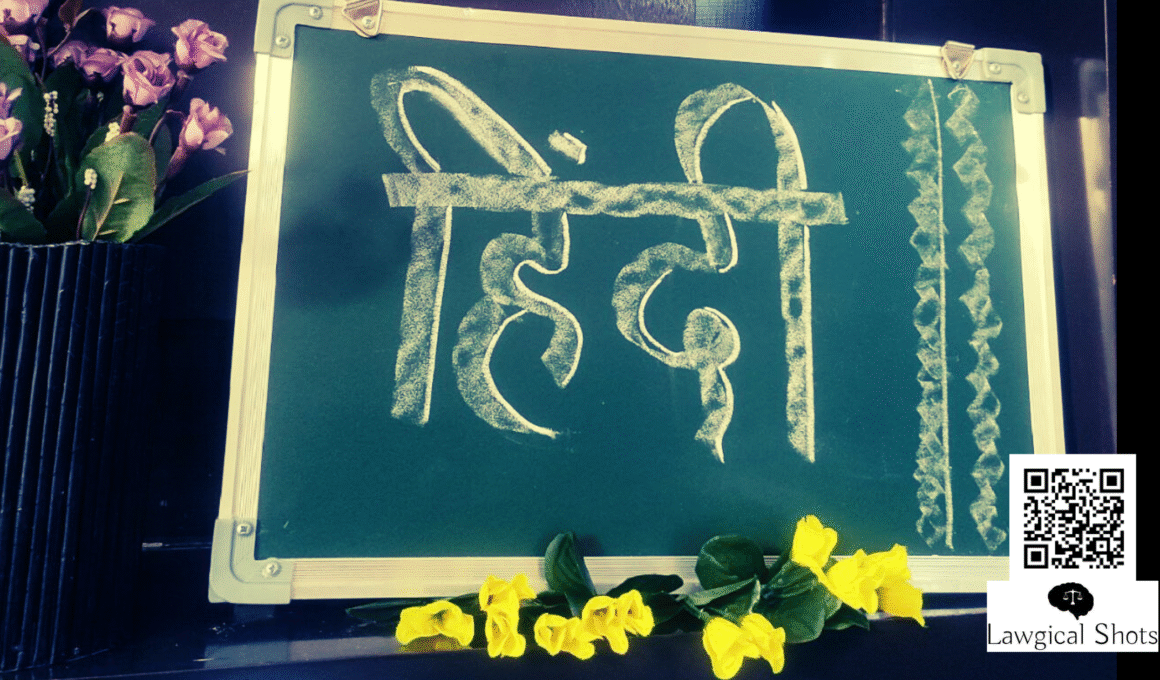“In a country where language should be a thread that weaves unity, it often turns into a wall that divides. Hindi, with its, historic roots and national importance, stands at the heart of this complex reality – celebrated by some, feared by others, yet indispensable to India’s story.”
Hindi – The Most Spoken Language of Hindustan
Hindi holds undeniable importance in our lives. Its roots run deep in our history, culture and collective identity. It is the most spoken Language in India, connecting millions across states and backgrounds. Yet, despite all this, there exists a fear among people that their own regional languages might lose relevance. That’s how the Hindi language controversy sprouted in India. We see this fear manifest in everyday life- people facing hostility, language based discrimination, or being made to feel unwelcome simply for speaking a different language.
Ironically, while many feel pride in speaking “English” – often seen as a language of opportunity – our own Indian Language, including Hindi, sometimes become a source of division. This raises a serious question: Are we truly progressing as a nation if language continues to divide us? Language should never be a barrier. It should be a bridge- a means to connect, to communicate, to understand one another better. Hindi, with its widespread presence, can serve as that bridge, but only when promoted with sensitivity, respect for regional languages and the shared vision of unity.
The Historical Journey of Hindi
Hindi belongs to the Indo- Aryan branch of the Indo- European Language family. Its roots can be traced back to Sanskrit, the ancient language of the Indian subcontinent. Over centuries, Hindi evolved through Prakrit and Apabhramsha, giving rise to the modern form we know today.
The standard form of Hindi is based on the Khariboli dialect, which originated in the Delhi region. In 1950, Hindi written in the Devangari Script was adopted as the official language of India through the Constitution. Back then, Hindi played a vital role in uniting people. During the Bhakti Movement (between 7th and 17th Centuries), poets like Kabir and Tulsidas used Hindi to spread messages of devotion and social harmony. Hindi literature flourished, enriching Indian Culture. During India’s freedom struggle, Hindi emerged as a language of mass communication with leaders using it to reach the common people and instil a sense of national unity.
Hindi in Modern India
In today’s India, Hindi is not just a means of communication but a powerful tool to unity. From Government offices to Bollywood movies, from newspapers to poetry, Hindi plays a dominant role in shaping the cultural and social fabric of the country. Interestingly, Hindi does have a Global presence. Countries like Nepal, Mauritius, Fiji, Trinidad and Tobago, Suriname and South Africa have significant Hindi-speaking populations, keeping the language alive beyond Indian borders.
The Hindi Debate: Unity or Imposition?
While Hindi is seen as a unifying force, its promotion has often led to fears of linguistic domination, especially in states like Tamil Nadu and Karnataka. The Anti-Hindi agitations of Tamil Nadu in 1965 reflect these concerns.
The reality is that India’s linguistic diversity is its strength. Hindi language controversy in India will only weaken us. Promoting Hindi should not come at the cost of undermining other languages but should foster national unity while respecting regional identities.
Real-Life Challenges: Language Divides India
While Hindi is seen as a unifying force, on the ground, language differences often lead to friction. A recent incident highlights this reality:
One of the Founders of a Bengaluru Based Tech Company had revealed that their company’s office in Bengaluru will be closed in six months and operations will be shifted to Pune. The reason was that several of their employees had faced language discrimination and fearing they might become a target of the same. The move came after a recent incident that sparked controversy, a State Bank Manager was transferred after a customer complained that she did not speak Kannada. The founder expressed concern that his employees could face similar target. Thus, the move to relocate was initiated by the employees themselves.
Recently, Amid escalating Marathi Language controversy in Maharashtra, Chief Minister Devendra Fadnavis said that that Hooliganism in the name of language will not be tolerated in the state, as reported by The Times of India. “Having pride in the Marathi Language is not wrong, but if someone engages in hooliganism in the name of language, we will not tolerate it’’. ‘’If anyone resorts to violence based on language, it will not be tolerated.’’ The CM’s remark came after a group of men belonging (MNS) scarves, thrashed a food stall owner for not speaking Marathi in Thane’s Bhayander.
Sadly, such incidents are not uncommon, and reflect the deep-rooted linguistic sentiments across different states. This reflects the real picture of Hindi language controversy in India. While it’s essential to respect regional languages, such divisions often create barriers for people who migrate for work, education, or business.
Hindi: Constitutional Recognition and Provisions
The makers of Indian Constitution recognized the complexities of language politics in our country. To balance diversity and unity, they made specific provisions regarding Hindi.
The Eighth Schedule of the Constitution recognizes 22 official languages, including Hindi. Among these, Hindi is the most spoken language in India and is often seen as a link language for communication across states.
Part XVII of the Indian Constitution deals with the official language of the Indian Union.
Article 343 – Official Language of the Union
- According to Article 343(1) of the Constitution, Hindi in the Devanagari script is declared the official language of the Union of India.
- This does not mean Hindi is the only language of India, but it is the language used for official purposes of the central government.
- Along with Hindi, English continues to be used for official purposes under Article 343(2), initially for 15 years but later extended indefinitely by the Legislature.
Article 344 – Commission and Committee of Parliament on Official Language
- The President shall, after 5 years and 10 years from the commencement of the Constitution, set up a Commission to make recommendations on the progressive use of Hindi for official purposes and restrictions on the use of English.
- A Parliamentary Committee is also constituted to examine the Commission’s report and give its opinion to the President.
Article 345 – Official language of a State
- State Legislature can adopt any language in use in the State or Hindi for official purposes. English will continue for official purposes until the State provides otherwise by law.
Article 346 – Official language for communication between States or with the Union
- The official language of the Union (currently English) will be used for communication between States and between States and the Union, though States can agree to use Hindi for communication between themselves.
Article 347 – Special provision for language spoken by a section of State population
- If a significant population of a State demands, the President can direct that their language be officially recognized for use within that State.
Article 351 – Directive for the Development of Hindi
- Article 351 gives the Union government the responsibility to promote and develop Hindi so that it serves as a medium of expression for all elements of the composite culture of India.
Article 120 and 210 – Allows use of Hindi or English in Parliamentary and state legislature proceedings.
Case Laws on Language Feud in India
The Hindi language controversy in India is not confined to layman feuds or Parliamentary debates. People have approached the Courts as well, as covered below:
In Prabandhak Samiti & Anr. v. Zila Vidyalaya Nirikshak (1976), the Allahabad High Court decisively held that writ petitions and allied pleadings drafted in Hindi, using Devanagari script, are fully valid under the Official Language provisions of Article 348(2). The verdict underlined that litigants could draft petitions, affidavits, written statements, and even engage in arguments and secure judgment, in Hindi. Such rulings may be delivered in Hindi, but must be accompanied by official English translations. This landmark judgment bolsters legal inclusivity and respects linguistic diversity in Indian courts.
In Varshatai v. State of Maharashtra (2025), the Supreme Court upheld the display of Urdu alongside Marathi on a municipal signboard, affirming that the Maharashtra Local Authorities (Official Languages) Act, 2022 does not prohibit such bilingual signage. The judgment beautifully emphasized that language is a means of communication—not a marker of religion or division—and recognized Urdu’s equally valid place under the Constitution’s Eighth Schedule. With notable observations such as ‘Language is not religion’ and ‘Let us make friends with Urdu and every language,’ the Court reaffirmed India’s multilingual ethos and rejected the politicization of language.
Role of Leaders like Amit Shah
Home Minister Amit Shah has been vocal about promoting Hindi as a link language. This move could put an end to the Hindi language controversy in India. His 2019 statement advocating for “One Nation, One Language” sparked significant debate. Shah clarified that the goal is to encourage the use of Hindi for ease of communication, not to impose it on non-Hindi speaking states.
Union Home Minister Amit Shah, speaking at the Department of Official Language’s golden jubilee on June 26, 2025, emphasised that Hindi is not in conflict with any Indian language – it is their “friend” or “companion.” He said Hindi and other Indian languages together can uplift national self-esteem, and stressed that governance should be conducted in the mother tongue to preserve culture and identity. Shah also stated there should be no opposition to foreign languages, but urged Indians to free themselves from a “slave mentality” by taking pride in thinking, expressing, and dreaming in their own language. He highlighted government initiatives like teaching medical and engineering in regional languages, promoting Hindi via the National Education Policy (NEP‑2020), and expanding tools like the digital Hindi dictionary Bhasha Sangam to teach commonly used phrases across 22 scheduled languages. Amit Shah’s message was one of linguistic harmony—asserting Hindi’s role as a unifying force alongside regional and foreign languages, not its competitor.
How Hindi Can Bridge the Gap
In a diverse country like ours, expecting everyone to learn every regional language is impractical. Here, Hindi, being the most spoken language in India and understood by millions across states, can serve as a practical link language.
- For a startup from Maharashtra trying to set up in Bengaluru, speaking Hindi could help employees from different states communicate internally.
- For workers migrating from Uttar Pradesh to Tamil Nadu, Hindi can help them connect with others in similar situations.
- For tourists, students, and entrepreneurs travelling across the country, Hindi, along with English, offers a common ground for communication.
The key is not to impose Hindi, but to encourage its use as a supplementary language, bridging gaps between communities while respecting regional languages and cultures, because a common language fosters understanding, reduces friction, and promotes unity without diluting diversity.
The English Obsession: A Double Standard
Ironically, in many parts of India, English is readily accepted – a language with colonial roots, that often alienates the common Indian. Yet, there is hesitation towards Hindi, an indigenous language spoken by millions. It is one of the biggest factors for Hindi language controversy in India.
We must ask ourselves:
Shouldn’t we prioritize an Indian language over a foreign one for national communication? Why allow English to dominate when Hindi can serve as a better cultural bridge?
Hindi as a Bridge, Not a Threat
Promoting Hindi does not mean suppressing mother tongues like Tamil, Bengali, Kannada, Marathi, or any other language. In fact, families and communities should proudly continue speaking their mother tongues. Hindi should be encouraged as a link language, easing communication between people from different regions. This approach reduces dependence on English, preserving Indian identity while respecting linguistic diversity.
Conclusion: “Unity in Diversity, Through Language”
India’s strength lies in its diversity, but unity is essential for progress. Promoting Hindi as a communication bridge, not as an imposition, can help:
- Strengthen national integration.
- Reduce language barriers between communities.
- Protect regional languages by limiting the excessive use of English.
- Enhance India’s global identity with Hindi as a proud, indigenous language.
Let Hindi unite us, let our mother tongues define us. Together, they create the soul of India.“Ek Bharat, Bhasha Anek — Hindi se mel, apni bhasha se garv.”
(One India, many languages — unity through Hindi, pride through mother tongues.)








